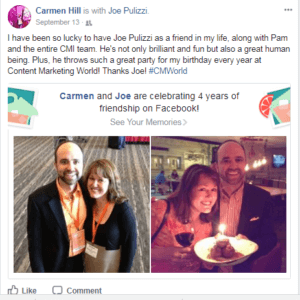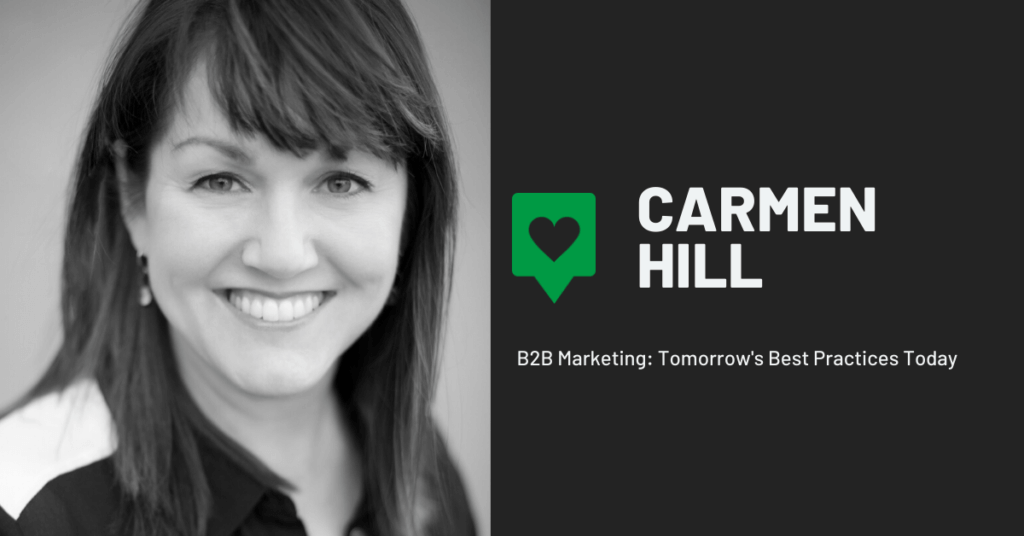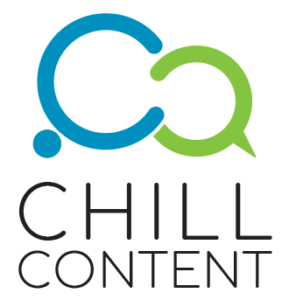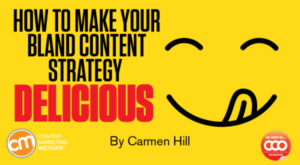In B2B Marketing: Tomorrow’s Best Practices Today, we feature expert interviews about the state of B2B Marketing and what the future holds. In this post, I interview Carmen Hill, content strategist and writer for Chill Content.
Tell us about yourself?
I’m an independent content strategist and writer, based in Portland, Oregon. Empty nester. Downtown dweller. Lifelong word nerd. Optimist.
My business is called Chill Content, which is a play on my first initial and last name. It also relates to my mantra for how I spend my time: cool work with cool people.
I take a strategic approach to B2B storytelling, helping clients connect brand to demand—and beyond—by putting audience and customer needs first.
I like bringing order to chaos through structure and organizational schemes. I’m a big fan of mind mapping and story mapping to find common themes and intersections that support connected content experiences. It’s like solving a puzzle.
Note: Follow Carmen on Twitter (@carmenhill).
Tell us about your background in B2B marketing?
I basically landed in B2B marketing by accident. I was a freelance writer re-entering the paid workforce after staying home with my kids for several years. It just so happened that one of my first assignments was with a B2B marketing agency called Babcock & Jenkins (BNJ).
They were way ahead of the curve on using marketing automation (their own proprietary technology) and dynamic content, personalized based on profile data. They needed someone to write these new-fangled things called e-newsletters for a high-tech client. As a journalist, I knew how to write articles—I learned B2B marketing on the job.
BNJ went on to lead the way on content marketing as well, and I was lucky to lead our content team to win an “Orange Award” for agency of the year at Content Marketing World in 2012. That’s still one of the best nights of my life!
Tell us a best practice of tomorrow that B2B marketers should be doing today?
I don’t know that I can pinpoint a single practice or tactic.
But I do believe we will need to adopt a more human-centered mindset and double down on empathy and emotional intelligence. In this age of chatbots and voice search, we, of course, have to get smart on things like AI and machine learning.
It's. All. About. Empathy!!!!! #CMWorld
— Sydni Craig-Hart | Multicultural Marketing Expert (@SydniCraigHart) August 13, 2019
Planning for all the ways people will experience our content—from websites to car dashboards to household appliances—is already a mind-boggling task.
But ultimately, the most valuable differentiator might not be how well you master the technological capabilities, but how well you use them to deliver better human experiences. (PS: I could geek out all day about how this relates to content and content strategy.)
What’s the difference between content strategy and content marketing?
Content strategy is a practice; content marketing is a purpose.
But I think this distinction has been overplayed—I care a lot less about the differences than I do the intersections. Content strategy is a big part of content marketing. But it’s also necessary for planning, creating and managing all kinds of content: website, product and technical documentation, customer support, etc.
Content strategy is a very big tent—encompassing a wide range of expertise and responsibilities. And the job description varies a lot depending on the size and type of organization you’re working with.
You wrote a great post for CMI, “How to Make Your Bland Content Strategy Delicious.” Give us a brief synopsis?
This is really about using all kinds of data to create hyper-relevant, insight-driven content and conversations with our customers and prospects—what my brilliant partner in crime, Julie Wisdom, calls an “account-based experience.”
By talking to your customers and your sales team, as well as analyzing behavioral, intent and install-base data, you can gain a deep understanding of both the emotional and rational drivers for B2B decision-making.
Then you can use those insights to create personalized content that is relevant, resonant and valuable.
Read the post at CMI, “How to Make Your Bland Content Strategy Delicious.”
Tell us about the content strategy course that you teach at Portland State University?

This course is offered through PSU’s Center for Executive and Professional Education and is part of the Digital Marketing Strategies program.
It’s Content Strategy 101 for professionals with a very broad spectrum of experience, most of whom are looking to add more digital skills to their professional toolkit.
A fun fact: I actually went through an earlier iteration of this program back around the dot-com boom, when I was looking to transition from TV news and full-time parenthood to a new career as a digital content creator.
I looked at the web and thought, “That’s going to involve a LOT of content. And I know how to make content.”
You’re in the Content Marketing World Hall of Fame! Give us your top three memories of that conference over the past 10 years?
The Rock Hall has Stevie Nicks.
The #CMWorld Hall of Fame also has a rock star: @carmenhill 🙌 pic.twitter.com/vrcXcMK49d
— Dennis Shiao (he/him) ✍️ (@dshiao) September 6, 2019
My best memories are of all the amazing people I’ve been lucky enough to meet through Content Marketing World and the Content Marketing Institute community. People like you!
Apart from that first memory in 2012 when I got to bring home the trophy for mid-sized agency of the year, I have great memories of getting to be a contestant on the Hollywood Squares game and of lip-syncing on the House of Blues stage in a “lip sync off” with Robert Rose—a good friend who is an actual musician and a very talented one at that!
Just picturing that again makes us laugh! #CMWorld
— Content Marketing Institute (@CMIContent) September 12, 2017
He came on with a push-broom guitar and tutu-clad backup dancers and mopped up the championship with Prince’s “Let’s Go Crazy.”
Not as good as seeing it live, but we think these photos rock. (Sorry, couldn't help ourselves.) #CMWorld cc @kathyklotzguest pic.twitter.com/DgQlaPTiru
— Content Marketing Institute (@CMIContent) March 18, 2020
The best part is that proceeds from that competition all went to well-deserving charities. And finally, maybe the best memory of all was being named as the CM World Community Champion in 2018.
So unexpected and exciting to be part of this very special cadre of other community members—people I am so lucky to have as friends.
Note: When Joe Pulizzi announced he was leaving Content Marketing Institute, he wrote, “I think of Carmen Hill and how she always willingly spends her birthday at CMWorld every year” and included this photo:

Image via Joe Pulizzi’s post, “A Content Marketing Love Letter.”
Explain your affinity for open browser tabs?
Today? 77 😳 Just one window, though! 😊
— Carmen Hill (@carmenhill) September 16, 2019
I’m a “yes and” person. I like keeping my options—and my browser tabs—open.
I don’t always have time to read everything I’d like to at the moment I find it. Or if I’m researching a topic, I might open a bunch of different pages and resources that I want to use.
It’s kind of like piling a bunch of books or magazines on your desk so that you can peruse and bookmark and easily come back to them.
And eventually, yes, some do just get naturally closed—when my computer’s available memory evaporates and I have to force-quit my browser.
Favorite restaurant in Portland?
This may be the most difficult question you’ve asked!
Portland has SO many amazing restaurants—I haven’t even been to all of the best ones yet. But I have several favorites, some that I’ve been going to for years. There are a couple I go to at least once a week when I’m in town, so I’m going to cheat and name both of them.

The first is Higgins. It’s been a Portland institution for more than 25 years—Greg Higgins was an original farm-to-table pioneer.
Their menu changes with the seasons. I am especially crazy about the late summer fare: I alternate between the heirloom tomato salad and the albacore tuna Nicoise salad.
I just ousted @asunder as the mayor of Higgins Restaurant & Bar on @foursquare! http://t.co/NNtDyKBV
— Carmen Hill (@carmenhill) January 22, 2013
We also go to Serratto for lunch almost every weekend.

Portland has this annoying obsession with brunch, so it’s hard to find anyplace that actually serves lunch.
Serratto has an excellent menu featuring fresh Italian dishes. My go-to is the kale salad with a side of grilled chicken.
Want to have a conversation about social media? Let’s talk.


